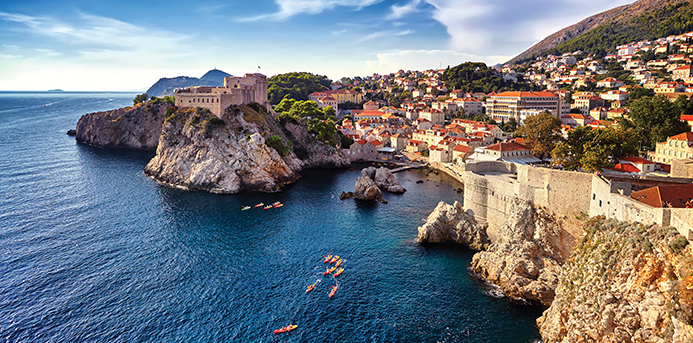“Look closely at this tapestry and you’ll notice something very strange,” says the museum guide, pointing to a book-size embroidered panel hanging on the wall and gesturing us to lean in until our noses almost touch the glass. “Do you see how fine the thread is? This was sewn by the wife of a sailor who was lost at sea for more than 25 years. She wove her own hair into the design — look, you can see it go from brown to gray as the years went by.” As if in answer to our unspoken question, she adds, “Sadly, the legend doesn’t tell us if he ever returned. But I like to think he did.”
It’s one of those eerie moments when a small story seems to embody and encapsulate the history, culture, and very essence of a place. In this case, that’s the Bay of Kotor in Montenegro, which has been defined by the sea and a history of conquest since it was a Roman seaport founded sometime before 200 B.C.
Even the tiny island we’re standing on, known as Our Lady of the Rocks, is tied to seafaring history. Legend has it that in 1452 a shipwrecked sailor (or two brothers, depending on the storyteller) pulled himself up onto a rocky outcrop and discovered an icon of the Virgin Mary. Vowing to build a chapel to honor his miraculous rescue, he and other grateful mariners began bringing stones back from each safely completed voyage and piling them up to build first the island, then the ethereal blue-domed chapel atop it. Completed in 1640 and largely rebuilt in 1722, the island appears to float on the surface of the water, visible from every shore.
Kotor: City of Castles
We haven’t come by sea, though, as the majority of those visiting the Bay of Kotor do, disembarking en masse from cruise ships for a day of sightseeing. Instead, my daughter and I came by public bus south along the Croatian coast from Dubrovnik, holding our breath as the vehicle dodged oncoming cars along the single narrow road hugging the inlet-studded shore. She’s in the midst of a five-month sojourn of backpacking through Europe, and I’ve joined up for this stretch to remember what it’s like to see the world this way.
Traveling overland, we’ve been able to spend days and nights exploring the old walled city of Kotor and taking day trips like this one, which finishes with a picnic lunch on the stone-walled quay in the bougainvillea-draped village of Perast.
From our room just inside the city’s ancient fortified walls, we’re awakened by bells ringing out from Kotor’s many churches, including the Cathedral of St. Tryphon and the orthodox churches of St. Luke and St. Nicholas.
We have time to spend a morning wandering the waterfront stalls of the Saturday farmers market and to climb the 1,350 steep, crumbling stone steps that switchback up the mountain to the Castle of San Giovanni, also known as the Fortress of St. John. We stop halfway up to visit the Chapel of Our Lady of Remedy, built in 1518 by grateful survivors of the plague, clamber down the backside of the mountain to the abandoned chapel of St. George, and stay to watch the sunset over the bay far below.
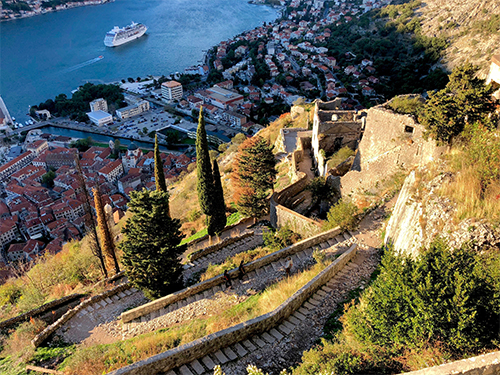
Heavily fortified in the early Middle Ages, Kotor still feels utterly medieval; it’s easy to imagine knights riding across the moat and jousting in the main square. But the Kotor you see today also looks and feels Venetian, having been part of that empire for more than 350 years, from 1420 to 1797, during which many of the current buildings were constructed or embellished.
The Mediterranean influence is deliciously evident in Kotor’s cuisine; choosing among the many cozy restaurants with their lamp-lit outdoor tables, we sample black risotto made from squid ink; octopus salad; and buzara, a deep bowl of shellfish and prawns cooked in white wine.
Other local specialties are influenced by the traditions of neighboring Croatia, Bosnia, and Serbia, as Kotor spent time under the rule of each. Market stalls overflow with the small, skinless cevapi sausages, soft cheeses in olive oil, and pastries such as burek, made from filo dough filled with spinach and cheese or ground meat. Not to be missed is riblja corba, a rich fish soup typically made from sea bass or mullet enhanced with potatoes, carrots, and sometimes tomatoes.
Mostar: More Than a Bridge
To our taste, though, nothing rivals the meals we eat in the Bosnian city of Mostar, which spent 500 years under Ottoman rule and still shows a great deal of Turkish, Greek, and Middle Eastern influence. The first thing we do upon arrival is visit Cafe de Alma, where owner Jasmin serves up a lesson on the history and ritual of Bosnian aka Turkish coffee, which we drink while relaxing on her sunny, rainbow-hued patio.
We’ve driven all morning through the rolling, vineyard-covered hills and valleys of southern Herzegovina, so we’re hungry and we head to Sadrvan, where waiters in traditional dress recommend we start with Mostarski Sahan, a sort of sampler platter featuring sogan-dolma, roasted onions stuffed with minced meat; japrak, a more traditional grape leaf dolma; and buttery rich potato and lamb stew topped with sour cream.
But we’re really just waiting for the crowds to thin so we can have Stari Most, the world-famous Ottoman bridge, to ourselves. The pet project of Ottoman emperor Suleiman the Magnificent, Stari Most is a true architectural wonder, seeming to defy gravity as its single span of white limestone arches high over the Neretva River. Completed in 1566 after 10 nail-biting years of construction, it was a symbol of Muslim-Christian peace until it was bombed seemingly beyond repair in the bitter wars for Balkan independence in the early 1990s. Painstakingly rebuilt block by block, it reopened in 2004 and has become a symbol of the slow, painful reconciliation process that’s still ongoing.
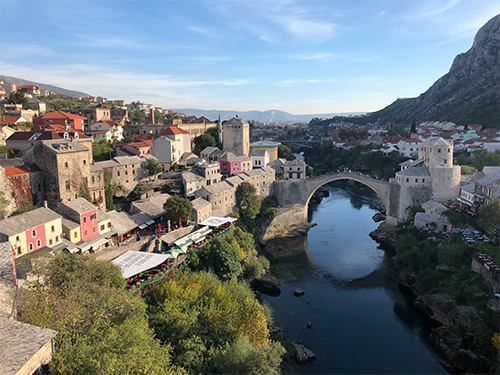
Mostar enchants us, from the calls to prayer echoing from its mosques to the Turkish bazaar of colorful crafts and market stalls to the still war-torn neighborhoods displaying bold murals of nationalist pride. Of course, we also love the cake shops and bakeries, where shelves glow with honey-soaked pastries, four-layer cream-filled cakes, and the elaborate puddings that were favorites of the Ottoman sultans.
Dubrovnik: The Fairy-Tale City
We finish — as we started — in Dubrovnik, today among the most popular and crowded destinations in central and southeastern Europe thanks to its role standing in for King’s Landing in “Game of Thrones.” But here’s what most people don’t know: visiting Dubrovnik is a completely different experience for those who stay within or just outside the old city walls.
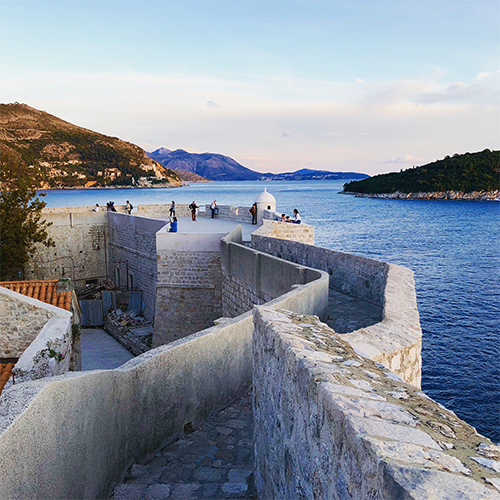
From its towering battlements to the smooth white paving stones that gleam underfoot, Dubrovnik feels like the setting of a chivalric legend, and having it all to yourself at night and in the early mornings lets you sense the magic the most. Dubrovnik is a dream for those who love to walk, and we do, climbing up to Fort Lovrijenak on its high rocky perch and scaling Srd Hill to visit Napoleonic Fort Imperial, which protected the city through many wars, including the battle for Croatian independence.
And we climb up one of the towers to walk the entire 1.2-mile circuit of the old city walls, considered one of the greatest fortifications of the Middle Ages, staying to watch the sunset touch the gleaming stones with gold.
The azure-blue Dalmatian coast is another draw here, and we spend two of our days visiting islands by ferry. Just an hour’s ride away, Lokrum’s attractions include a Benedictine monastery-turned-palace surrounded by courtyards and a botanical garden. The grounds have become a sanctuary for escaped peacocks and fluffy rabbits happy to nibble from your hand. Many people also come to the island to swim in its secluded coves, dive off the craggy rocks, or float in the iridescent blue-green “dead sea” saltwater lake connected to the ocean by underground caves.
Lopud, one of a group of islands called Elafiti, is as popular for its white sand beach as it is for the Franciscan monastery that looms dramatically over the port. The ferry rides themselves are a highlight, offering endless photo opps of Dubrovnik’s famed seawalls and the islands’ craggy coastlines and peaceful harbors.
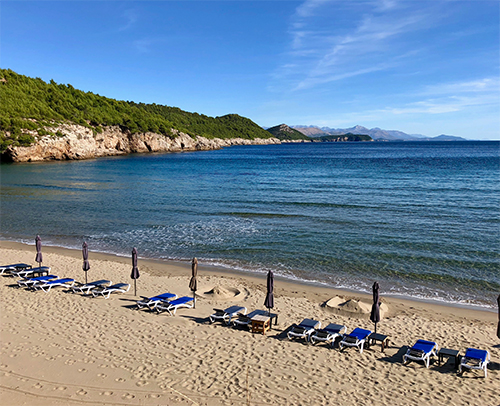
On our second-to-last day in Dubrovnik, the city’s many plazas and parks suddenly bloom with flower stalls, each vying to outdo the others with massive arrangements of white and yellow chrysanthemums, daisies and roses of all hues. Checking the calendar, we realize that tomorrow is All Saints Day, to be followed by All Souls Day, when Central European Christians honor deceased family members by cleaning and decorating their graves.
Before heading for the airport, we wake early to watch families proceeding into the beautiful Cemetery of Boninovo and marvel at the care and beauty lavished on each mausoleum. Noticing the clusters of red glass lanterns, we ask their significance and an elderly woman looks surprised at our ignorance. “They light the way into heaven,” she says. It seems a fitting endnote for a trip that’s shown us the ways in which Balkan traditions remain strong despite hundreds of years of conquest, upheaval, and death by land and sea.
This article originally appeared in Marin Magazine.
